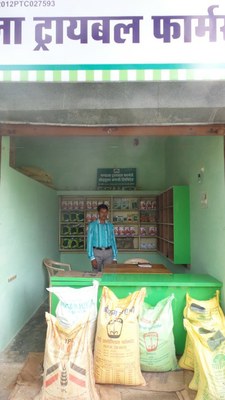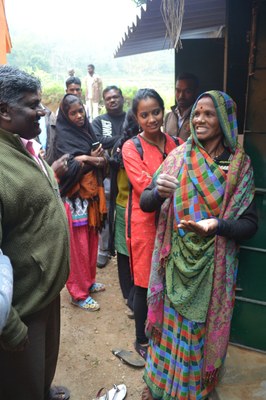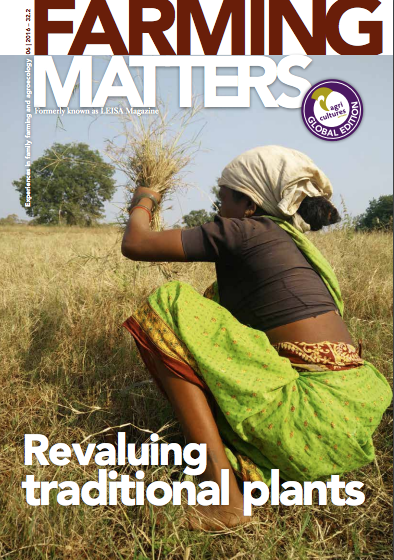A decline in minor millet cultivation rings true across much of India. Yet a country wide revival of this cereal crop is in motion. Farmers are again recognising and asserting the value of minor millets, a cereal crop that was once central to their culture. A group of farmers in Madhya Pradesh have taken strength from farmers in Tamil Nadu who have successfully brought millet back into their fields, their homes and onto plates across their region. This is a story of how learning exchanges and partnerships support amplification of succcessful initiatives.

Millet cultivation started to fall out of favour in India during the green revolution when input intensive farming systems dominated by wheat, rice and maize were systematically promoted. During the past decades, the public distribution system, a scheme where the Indian government provides rice and wheat at subsidised rates to low income households, has further discouraged the use of millets. But, from the ground up, farmers, NGOs and scientists have started a millet revival that has even reached national policy. Several farming communities have succeeded in reviving their lost tradition of cultivating millets and two years ago millet was added to the public distribution system. A relatively new experience amongst the indigenous Gond and Baiga farmers in Mandla and Dindori districts in Madhya Pradesh gives insight into how the millet revival is unfolding across India.
Climate resilience

Traditionally minor millets were the major staple for farmers in Mandla and Dindori districts. They were cultivated and consumed in abundance – central to the rain fed farming systems, an important source of sustenance, and featuring in traditional songs. These cereals can produce a reliable harvest under the harsh conditions of this region that is characterised by rocky, thin topsoil and limited irrigation facilities. Since the 1970s, millet cultivation has been pushed into ever more marginal areas to make way for rice and maize. Paddy was once grown in more limited quantities and was considered a delicacy. Now, farmers in this region tend to focus their effort on wage labor and cultivation of paddy and maize. In the monsoon season, paddy is grown in the lowest elevations where moisture is greatest, maize is cultivated on gentle slopes, while kodo (Paspalum scrobiculatum) and kutki millets (Panicum sumatrense) are grown only in the steepest and highest areas.
Storefront of the Mandla Tribal Farmer Producer Company selling high quality millet seed to local farmers.
But, Gond and Baiga farmers recognise that their traditional millets are more reliable under increasingly drought-prone conditions. “Our crops depend on whatever falls from the sky. Paddy requires more water but kutki will grow even in the absence of heavy rainfall,” said a farmer from Mandla district. In 2015, eastern Madhya Pradesh received just 30 % of the usual amount of rainfall which led to crop failures and serious rural distress. The steady progression of climate change means that cultivating climate-hardy millet is an ever more important strategy.
Constraints
Despite their benefits, low productivity, weak market opportunity, difficult processing, and low consumer interest are constraints to continue millet cultivation. These constraints for millet use are not unique to Madhya Pradesh however, and they can be overcome. In Kolli Hills, Tamil Nadu, 15 years of collaboration between farmers, the M.S. Swaminathan Foundation and Bioversity International has resulted in a so called ‘holistic value chain approach’ which addresses issues of production, processing and consumption at the same time.
An approach which addresses production, processing, and consumption at the same time
Action for Social Advancement (ASA), an NGO based in Central India, with a longstanding relationship with farmers in Mandla and Dindori districts, is applying this holistic approach in Madhya Pradesh to address challenges for millet use as part of a global initiative to promote climate hardy and nutritious underutilised species. The initiative is supported by the International Fund for Agricultural Development, the European Union and the CGIAR Research Programme on Climate Change Agriculture and Food Security.
Success in Kolli Hills
In Kolli Hills from 2014-2016, an estimated 56 tonnes of millet was produced by 759 local farm families across 45 settlements. It was used for home consumption, stored as seed, or sold. The backbone of Kolli Hill’s success is the Agrobiodiversity Conservers’ Federation (KHABCoFED), a registered society involved in managing minor millets from the farm to fork. The current membership stands at 1,511 members from 47 self-help groups and 62 farmers’ clubs that specialise in different roles – from production, processing, value-adding to distribution. The initiative was built over time; it started in 1997 with 10 self-help groups and was institutionalised in 2009.
Their success with collective processing, value-adding and marketing have proven that millets can play an important role in rural livelihoods again. Mechanised mills have reduced the drudgery of processing millet grains. Women used to spend up to an hour manually processing one kilogram of grain and now it takes just five minutes. Food fairs, innovative recipes and successful marketing of value-added millet products have increased the amount of millet consumed across the region. And, the 15 farmer-run seed banks containing 21 landraces from five millet species are enabling farmers to conserve local seeds and nurture their seed exchange practices.
A lesson in collective organisation
The way farmers in Kolli Hills are organised has proven very successful. ASA is taking steps to support farmers in Mandla and Dindori districts in a similar way. In 2011, ASA supported the formation of more than 200 self-help groups amongst farmers in about 50 villages. Members from these groups formed the basis of three farmer producer companies that were established in 2013 and 2014. The farmer producer companies have storefronts, warehouse facilities and infrastructure needed to process and distribute the grain. All profits are distributed equitably among the farmers who collectively own the company, the majority of whom are women.
A success to date has been that, through the production companies, farmers are receiving a better price for their grain. The companies carry out primary cleaning, grading and colour sorting and as a result farmers share in the value-added price. On top of this, aggregation of grain enables bulk sale to reduce the number of middlemen between the farmers and consumers. The companies are also working to make available high quality kodo, kutki and finger millet seeds. This has involved participatory variety selection with several farmers specialising in seed production. Looking further afield, the farmer producer companies have joined a consortium made up of 51 farmer producer companies from across the state to facilitate larger scale transactions.

Locally adapted minor millets
Owing to their nutritional value, hardiness and cultural relevance, minor millets are all but minor. The green revolution put them aside but today their rediscovery is opening up huge opportunities for unleashing their benefits. Traditionally considered as a separate group from the other ‘major’ millets (sorghum and pearl millet), minor millets in India include six species: foxtail millet (Setaria italica), finger millet (Eleusine coracana), proso millet (Panicum miliaceum), kodo millet (Paspalum scrobiculatum), little or kutki millet (Panicum sumatrense) and barnyard millet (Echinochloa colona).
These crops play an important role in food and farming systems in both sub-Saharan Africa and India. Their short growing season makes them well suited to rainfed farming conditions. Compared to rice and wheat, they require relatively few inputs. Millets offer a wide variety of flavours, excellent taste, crispy or fluffy textures that can make our food experience both healthier and more attractive. They are nutritionally superior to wheat and rice in many aspects. For instance, finger millet has the highest calcium content among all cereals. Their starch composition and low glycemic index (which make them ideal for diabetic patients) are also accompanied by gluten free status of the flour.
Farmer to farmer knowledge exchange
Since seeing is believing, farmers from Madhya Pradesh and Kolli Hills have been involved in a number of knowledge and cultural exchanges. Last year farmers from Kolli Hills visited Mandla to share recipes and methods for preparing millets. This was such a success that when community members from Mandla participated in the Indigenous Terra Madre event in northeast India they prepared a kodo ladoo, a traditional sweet recipe, that they learnt from the Kolli Hills farmers. In January 2016 seventeen custodian farmers from Mandla and Dindori visited Kolli Hills, where they saw community seed banks, village-based mills, and the storefront where packaged final products are sold and distributed. They also had the opportunity to taste several millet dishes.
“These people are our people”
These exchanges are beneficial from both a learning point of view and for the unique experience of meeting people who share similar lifestyles, challenges and aspirations. “These people are our people,” said Khantibai, a female farmer from Mandla district. The visiting farmers were excited to find similarities between their native language, Gondi, and Tamil. Moreover, the cottage-scale machinery for millet processing in the villages that the farmers saw in Kolli Hills, could be strategic in increasing the use of millets in Madhya Pradesh. This would be particularly beneficial for women who traditionally spend hours grinding and separating stones from the small grains. All of the farmers were enthused to take their knowledge back to their villages and share it with the members of their self-help groups.
Millet on the menu
Another lesson from Kolli Hills is that awareness campaigns amongst rural and urban populations are key to getting these climate hardy crops back on their plates. ASA has organised a number of millet festivals in the district centres that provide a platform for producers to showcase their millet. Prizes for ‘the tastiest dish’ and ‘the most popular stall’ and the presence of government officials has proven a successful way of boosting self-esteem amongst producers and revalidating this traditional crop and food.
The path towards a full millet revival in Mandla and Dindori districts continues and increasing demand for the crop is an important priority. Staff from ASA recently visited three local primary schools to discuss climate change and the role of climate resilient crops such as millet for adaptation. At the same time the self-help groups are negotiating with these schools to provide lunches and, without a doubt, millet will be on the menu.
Ashis Mondal, Somnath Roy, Shambhavi Priyam and Sharad Mishra work for Action for Social Advancement (asa@asabhopal.org).
Israel Oliver King works for M. S. Swaminathan Foundation.
Gennifer Meldrum (g.meldrum@cgiar.org) and Stefano Padulosi work for Bioversity International.

